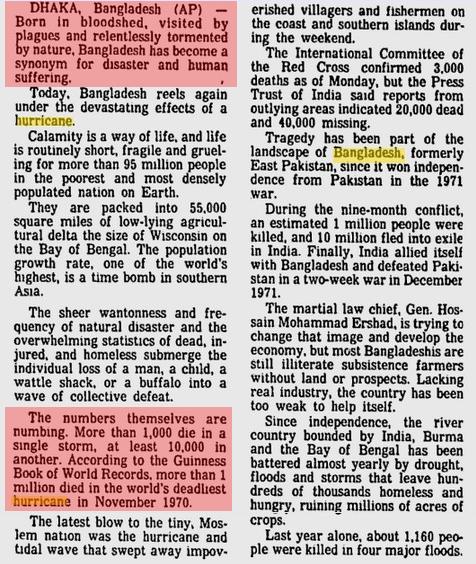Bangladesh is the canary in the coal mine when it comes to journalists lying about climate change.
‘We have seen the enemy’: Bangladesh’s war against climate change
Devastating cyclones, floods and ruined crops have made Bangladesh ‘the world’s most aware society on climate change’“I am quite amazed at how people are grappling with climate change and are adapting,” said Saleemul Huq, a Bangladeshi scientist who is head of the climate change group at the International Institute for Environment and Development in London and an adviser to the Bangladesh government on how to adapt to climate change.
“It’s by far the most aware society on climate change in the world,” Huq said. “It has seen the enemy and is arming itself to deal with it. The country is now on a war footing against climate change. They are grappling with solutions. They don’t have them all yet but they will. I see Bangladesh as a pioneer. It has adapted more than any other country to the extremes of weather that climate change is expected to bring.”
‘We have seen the enemy’: Bangladesh’s war against climate change | Environment | guardian.co.uk
Bangladesh has a climate problem, not a climate change problem. It is located on a flood plain a few feet above sea level. It floods there regularly and always has since the day it was created. The deadliest hurricane in history occurred there in 1970.
|




Enough Steven! Why in the hell should we bother about History?
There are a lot of lessons we can learn from history!
“Bangladesh has a climate problem, not a climate change problem.”
Well, I think it is a problem on the one hand, but also the reason it has the most productive agriculture in the world with five harvests a year.
As a Bangladesh, I never heard of five harvest in Bangladesh. At best, 3 harvest.
Bangladesh also had the world’s deadliest tornado in 1989, killed well over 1,000. You could reduce CO2 to 200 ppm and they would still have devastating hurricanes, tornadoes and monsoonal floods.
Their problem is dense population in a low lying area and flimsy contruction of overcrowded buildings.
Great post and links, reminded me of my elementary studies in geography of some 50 years ago. I actually loved learning about the wide world, but sadly now multi-multiculturalism replaces that kind of curriculum.
That is what makes college degrees worthless and a joke today.
Not only a joke, but they pretty much seal the brains with the false impressions that they are “educated”, yes, and they are, but if daylight ever shines upon their minds they’ll be horrified to learn that education was indoctrination into a false narrow parody of life. 🙁
Too many people in the wrong place!
Bangladesh, aka East Pakistan, East Bengal, Bengal, this country is deluged by monsoons and monsoon run off from the Himalaya mountains filling the Ganges and Brahmaputra river basin and missive flood plains down to the world’s largest river delta. The coastal area, Bay of Bengal is subjected to mean annual rainfall is 50” to 60” in the west and over 100” in the north.
Coupled to this 150 million population (~40 million live in coastal regions) at an average density of close to 900 persons/km2!
With over a hundred years of geoengineering throughout the country – dams, river rerouting, vast irrigation project, levees, land reclamation, deforestation, etc, – a natural country this is not!
———-Basically too many people live in the wrong place.———————-
For more info look here –
http://www.fao.org/docrep/005/ac623e/ac623e0b.htm
http://www.fao.org/docrep/010/ag124e/AG124E05.htm
http://wattsupwiththat.com/2011/01/03/bangladesh-the-poster-child/
__________________________________________________________
A few more weather events include –
1960 Oct 10, A cyclone and tidal wave hit the Gulf of Bengal and killed about 6,000 in East Pakistan.
1963 May 20-1963 May 23, In East Pakistan a cyclone killed about 22,000 along coast of the Bay of Bengal.
1964 Apr 11, The Bangladesh Observer (East Pakistan) reported that as many as 500 people may have died as a tornado destroyed villages in the Narail and Magura regions of Jessore.
1965 May 11-1965 May 12, In East Pakistan a cyclone killed some 12,000.
1965 Jun 1-1965 Jun 2, The 2nd of 2 cyclones in less than a month killed 35,000 along the Ganges River in East Pakistan.
1969 Apr 14, A tornado struck Dacca in East Pakistan killing 660.
1970 Nov 12, A 240 KPH cyclone hit East Pakistan (Bangladesh) [see Nov 13].
1970 Nov 13, The Bhola Cyclone killed an estimated 300,000 in East Pakistan (Bangladesh). The highest loss of life and destruction occurred on the low lying islands of the Ganges Delta south of Dhaka. In particular the island and district of Bhola, where casualties may have exceeded 100,000 alone, with the towns of Charfasson and Tazumuddin being devastated. The city of Chittagong was also badly affected. The official death toll was put at 150,000, with 100,000 people missing. However many estimates put the true figure as high as 500,000.
1988
Aug.-Sept., Bangladesh: heaviest monsoon in 70 years inundated three-fourths of country, killing more than 1,300 and leaving 30 million homeless. Damage estimated at over $1 billion.
1991
April 30, southeast Bangladesh: cyclone killed over 131,000 and left as many as 9 million homeless. Thousands of survivors died from hunger and water-borne disease.
And this does not include the many Tsunami that have also engulfed the large coastal area over the years.
It’s more of exagaration of situation and boasting without any such reasons. The realities are far from what has been said about climate linked disasters. It would be appropriate that leaders from Bangladesh think and work more on governance aspect rather making hue and cry about climate change to just milk funding.! Do think about judicious use of available funding and work on making the governance system just, transparent and workable..! A strong ‘will’ of working for larger welfare can work better than just ‘funding’ ..!